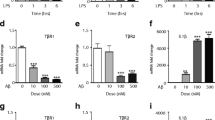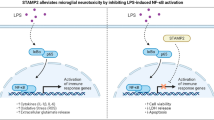Abstract
Expression of the NF-KB-dependent genes responsible for inflammation, such as TNF-α, IL-1(3), and nitric oxide synthase (NOS), contributes to chronic inflammation which is a major cause of neurodegenerative diseases (i.e. Alzheimer’s disease). AlthoughNF-kB plays a biphasic role in different cells like neurons and microglia, controlling the activation ofNF-kB is important for its negative feedback in either activation or inactivation. In this study, we found that ursodeoxycholic acid (UDCA) inhibited IkBα degradation to block expression of the NF-KB-dependent genes in microglia when activated by β-amyloid peptide (Aβ). We also showed that when microglia is activated by Aβ42, the expression of A20 is suppressed. These findings place A20 in the category of “protective” genes, protecting cells from pro-inflammatory repertoires induced in response to inflammatory stimuli in activated microgliavia NF-kB activation. In light of the gene and proteins for NF-KB-dependent gene and inactivator for NF-kB (IkBα), the observations now reported suggest that UDCA plays a role in supporting the attenuation of the production of pro-inflammatory cytokines and NOvia inactivation ofNF-kB. Moreover, anNF-kB inhibitor such as A20 can collaborate and at least enhance the anti-inflammatory effect in microglia, thus giving a potent benefit for the treatment of neurodegenerative diseases such as AD.
Similar content being viewed by others
References
Aisen, P. S. and Davis, K. L., Inflammatory mechanisms in Alzheimer’s disease: implications for therapy.Am. J. Psychiatry, 28, 1105–1113 (1994).
Akama, K. T., Albanese, C., Pestell, R. G., and van Eldik, L. J., Amyloid-β-peptide stimulates nitric oxide production in astrocytes through an NF-KB-dependent mechanism.Proc. Natl. Acad. Sci. U.S.A., 95, 5795–5800 (1998).
Arenzana-Seisdedos, F., Thompson, J., Rodriguez, M. S., Bachelerie, F., Thomas, D., and Hau, R. T., Inducible nuclear expression of newly synthesized IkBα negatively regulates DNA-binding and transcriptional activities ofNF-kB.Mol. Cell Biol., 15, 2689–2696 (1995).
Baeuerle, P. A. and Baltimore, D.,NF-kB: ten years after.Cell, 87, 13–20 (1996).
Baldwin, A. S., TheNF-kB and I kappa B proteins: new discoveries and insights.Annu. Rev. Immunol., 14, 649–683 (1996).
Barger, S.W., Horster, D., Furukawa, K., Goodman, Y., Krieglstein, J., and Mattson, M.P., Tumor necrosis factors á and a protect neurons against amyloid β-peptide toxicity: evidences for involvement of a kB-binding factor and attenuation of peroxide and Ca2+ accumulation.Proc. Natl. Acad. Sci. U.S.A., 92, 9328–9322 (1995).
Bauer, J., Strauss, S., Schreiter-Gasser, U., Ganter, U., Schlegel, P., Witt, I., Yolk, B., and Berger, M., lnterleukin-6 and alpha-2-macroglobulin indicate an acute-phase state in Alzheimer’s disease cortices.FEBS Lett., 285, 111–114 (1991).
Behl, C., Davis, J. B., Lesley, R., and Schubert, D., Hydrogen peroxide mediates amyloid beta protein toxicity.Cell, 77, 817–827 (1994).
Carter, B. D., Kaltschmidt, C., Kaltschmidt, B., Offenhauser, N., Bohm-Matthaei, R., Baeuerle, P. A., and Barde, Y. A., Selective activation ofNF-kB by nerve growth factor through the neurotrophin receptor p75.Science, 272, 542–545 (1996).
Cjaza, A. J., Carpenter, H. A., and Lindor, K. D., Ursodeoxycholic acid as adjuvant therapy for type 1 autoimmune hepatitis: a randomized placebo-controlled treatment trial.Hepatology, 30, 1381–1386 (1999).
Dhib-Jalbut, S. S., Xia, Q., Drew, P. D., and Swoveland, P. T., Differential up-regulation of HLA class I molecules on neuronal and glial cell lines by virus infection correlates with differential induction of IFN-beta.J. Immunol., 155, 2096–2108 (1995).
Ferran, C., Stroka, D. M., Badrichani, A. Z., Cooper, J. T., Wrighton, C. J., Soares, M., grey, S. T., and Bach, F. H., A20 inhibitsNF-kB activation in endothelial cells without sensitizing to tumor necrosis factor-mediated apoptosis.Blood, 91, 2249–2258 (1998).
Ghosh, S. and Karin, M., Missing pieces in theNF-kB puzzle.Cell, 109, Suppl., S81-S96 (2002).
Hou, S., Guan, A., and Ricciardi, R. P., Phosphorylation of serine 337 ofNF-kB p50 is critical for DNA binding.J. Biol. Chem., 278, 45994–45998 (2003).
Israel, A., The IKK complex: an integrator of all signals that activateNF-kB.Trends Cell Biol., 10, 129–133 (2000).
Joo, S. S., Won, T. J., Kang, H. C., and Lee, D. I., Ursodeoxycholic acid inhibits pro-inflammatory repertoires, IL-1β and nitric oxide in rat microglia.Arch. Pharm. Res., 26, 1067–1073 (2003).
Kaltschmidt, B., Uherek, M., Volk, B., Baeuerle, P. A., and Kaltschmidt, C., Transcription factorNF-kB is activated in primary neurons by amyloid beta peptides and in neurons surrounding early plaques from patients with Alzheimer disease.Proc. Natl. Acad. Sci. U.S.A., 94, 2643–2647 (1997).
Kaltschmidt, C., Kaltschmidt, B., Lannes-Vieira, J., Kreutzberg, G. W., Wekerle, H., Baeuerle, P. A., and Gehrmann, J., Transcription factorNF-kB is activated in microglia during experimental autoimmune encephalomyelitis.J. Neuroimmunol., 55, 99–106 (1994).
Lee, E. G., Boone, D. L., Chai, S., Libby, S. L., Chien, M., Lodolee, J. P., and Ma, A., Failure to regulate TNF-inducedNF-kB and cell death responses in A20-deficient mice.Science, 289, 2350–2354 (2000).
Moynagh, P. N., Williams, D. C., and ONeill, L. A., lnterleukin-1 activates transcription factorNF-kB in glial cells.Biochem. J., 294, 343–347 (1993).
Norris, J. G., Tang, L., Sparacio, S. M., and Benveniste, E. N., Signal transduction pathways mediating astrocyte IL-6 induction by IL-1b and tumor necrosis factor-a.J. Immunol., 152, 841–850 (1994).
Pahl, H. L., Activators and target genes of Rel/NF-kappaB transcription factors.Oncogene, 18, 6853–6866 (1999).
Rodrigues, C. M. P., Ma, X., Linehan-Stieers, C., Fan, G., Kren, B. T., and Steer, C. J., Ursodeoxycholic acid prevents cytochrome c release in apoptosis by inhibiting mitochondrial membrane depolarization and channel formation.Cell Death Differ., 6, 842–854 (1999).
Author information
Authors and Affiliations
Corresponding author
Rights and permissions
About this article
Cite this article
Joo, S.S., Won, T.J. & Lee, D.I. Potential role of ursodeoxycholic acid in suppression of Nuclear factor kappa B in microglial cell line (BV-2). Arch Pharm Res 27, 954–960 (2004). https://doi.org/10.1007/BF02975850
Received:
Issue Date:
DOI: https://doi.org/10.1007/BF02975850




